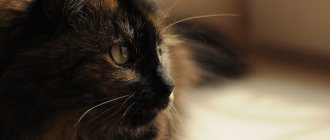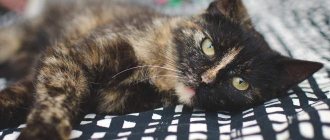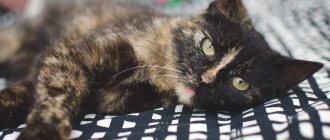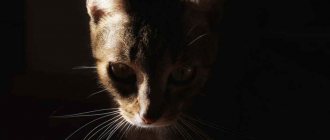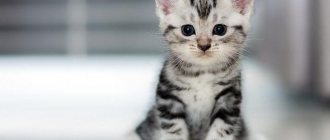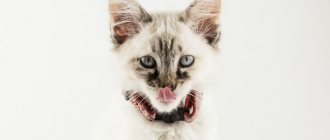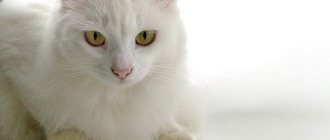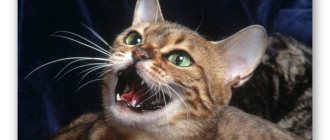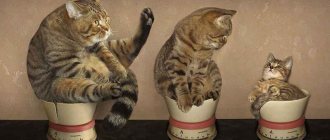Cats are mysterious animals, their behavior is always capricious, even if they are generally affectionate domestic cats.
It’s no wonder that many owners of purring cats often wonder what the cat is thinking about and what its mustachioed head is doing at a particular moment. Of course, there is no exact answer to this intriguing question, but still some scientific research sheds some light on the problem.
First you need to understand and accept that a cat, like any other animal, thinks and operates with a completely different value system than a person. All her thoughts and actions are determined by instincts and accumulated experience.
How cats think
Let’s immediately make a reservation: scientists are not yet able to fully study the thought process of a cat.
One thing is reliably clear: animals belonging to wild nature, in order to survive, must think through all the likely scenarios of events and keep in mind where danger awaits them. They summarize their own experience and draw conclusions from it, thanks to their memoirs. For example, if a pet remembers that a certain action incites unpleasant feelings, avoiding discomfort and stress, he will try not to repeat it.
Cats lack abstract thinking - for this purpose they do not have the necessary part of the cerebral cortex - and they cannot consider their actions (as, for example, people do). They cannot talk about what happened; only ordinary connections are available to them.
And also, the cat’s thinking connects some actions with stimuli that are important to it. For example, if she sees a toy, her brain makes a reference to the past and opens a memory of the game process. But on boring evenings the cat will not remember the toy.
Q: Is psychology a science?
This is a normal question that everyone asks.
Both psychology students and people who study psychology. The answer is simple: everything that meets the criteria of being scientific and is labeled as science is science. In the 30s of the last century, Karl Popper introduced the criterion of falsifiability of theories: that is, any theory can be considered scientific if it can be refuted by any facts or experiments on empirical material. The problem of psychology here is obvious: the theory will be associated with general concepts that are abstract, but the material world is here and now. In order to meet this criterion, psychology has the concept of operationalization
. This is when I take an abstract concept and come to a conventional opinion about how we will calculate this concept. An example would be the speed of response to certain stimuli.
I’m actually a cognitive psychologist (I’ll explain what that means soon). It could also be processing speed, response accuracy, or many other operationalization concepts. Thus, theories, thoughts, ideas that relate to psychology can be either scientific or not scientific at all. Non-scientific theories include classical psychoanalysis, for example: it simply cannot be refuted. Because, according to classical psychoanalysis, everything is possible. At the same time, from psychoanalysis over 60 years of development of thought, theories have grown that are refutable. For example, Mary Ainsworth's attachment theory, where we are interested in how early childhood experiences influence human development.
Further, in psychology there is a cognitive direction. It can be considered the gold standard of science; it fully meets the scientific criteria. The most developed theories include Alan Baddeley's working memory theories; you can look at many different theories about how the idea of working memory has changed, as empirical material, the results of experiments allowed us, as a scientific direction, to improve this knowledge and make it more accurate. At the moment, the working memory theory consists of several separate parts that have not yet been refuted in experiments. That is, according to Popper, none of them will be true, but we say that we simply do not have enough material to disprove it. And another problem of any theory is the methodology of science as a whole. An old theory can only be replaced by a new theory. You can’t just say that the old one doesn’t work, you need to present a new paradigm, an explanation for old phenomena and new paradoxes.
I am currently researching neuroimaging in developmental disorders, although I started 12 years ago with research on concept formation. I have always been interested in how people form concepts, how they learn new things, and how mistakes happen in this story. For the last 4 years I have been doing neuroimaging, psychophysiology, and also doing MRI in people with developmental disorders - autism, dyslexia, and a class of other disorders.
Can cats think about the future?
A cat dreaming about its favorite food is a fiction. Cats don't know how to imagine something that doesn't exist. They are, one might say, realists, which is why they have such a hard time with moving, trips to the veterinarian, changing food and any other “future”.
Cats live in the present, not the future. However, they still know a little how to predict: having received a certain stimulus in the past, a cat will be guided by it in the future. For example, a carrier can remind a cat of an unpleasant visit to the veterinarian - so it turns into a hyperlink to the veterinarian's fear: the cat already knows what awaits it in the near future. Which means it's time to start being afraid.
Q: How do you understand how parts of the brain are connected? Pathways or anatomical structures that connect?
There is a special method for this - this is DTI.
In this situation, we are interested in how the water reacts to the magnet, since you will experience a change in the direction of the water molecules. And along these directions we build white matter pathways. Here you need to understand that this is the part where a lot of programming happens, because an MRI is not a camera. I often use this metaphor when I tell students or colleagues about how MRI works: that is, I have no other way to know 100% what is happening in the body other than an autopsy. But, of course, I want the subjects to be alive.
MRI allows us to predict with high accuracy what our pathways look like, but they are still models. This includes when you go to the doctor and he tries to understand from your scan how different parts of your brain are connected. Different methods have different accuracy, and over the years the quality of the methods improves - this is also part of my tasks. People with different expertise work here, and it will always be an interdisciplinary science, where people with education in physics, engineers, mathematicians, and also, including people involved in cognitive and developmental psychology, will build the most plausible model.
What do cats think about?
Cats don't care about jewelry or money, nor are they concerned about work tasks. Here is a list of questions that occupy cats' thoughts:
- The most important resource is food. The cat may think about being hungry and how to get food: hunt/yell at the owner or caress his feet.
- Safety - the cat thinks whether it is safe, whether something threatens its life.
- Sleep - can she sleep, is now a safe time for this.
- Pain - if a cat is bothered by something, it will think about the sore spot.
- In a sense, grooming calms the cat down; she can’t help but think about it.
- About the owner - the cat thinks about him when there is a need for a person, a need for affection and care.
In addition, cats can concentrate on some object. If a cat has discovered a place where treats are stored, she will strive for it, even if she does not see the treat or hear its smell. The same applies to other items that are not so necessary for the cat, but have aroused her interest. For example, the shoes that you put in the closet did not miraculously disappear for your cat. And for a dog, if you have performed such an action, you are an illusionist Houdini.
Thinking, consciousness and self-awareness of a cat (part 12)
So, do cats think? Of course, they cannot think in our human understanding of the word, but they have access to mental processing of information entering the brain, on the basis of which they make decisions about their further actions.
They have internal representations of the material world around them, they perceive certain physical laws (for example, that objects do not cease to exist when they are not visible to the eye), they have a good sense of time, they can identify other cats, some people and a number of items.
Intelligence is defined by people and judged by human abilities. Children are taught to look where the finger is pointing. With cats, if you point at an object, the cat will look at your finger and not where it is pointing. To attract your cat's attention to an object, you need to touch the object itself.
One of the parameters of intellectual development is self-awareness. A popular test for self-awareness is to observe how an object (human or animal) reacts to its reflection in a mirror. Humans and great apes recognize themselves in him. If you smear paint on a child's nose or a chimpanzee's face and let them look in the mirror, both the child and the monkey will try to wipe the stain off their face rather than the mirror.
If a mirror is placed in front of a cat, then at first it looks for an unfamiliar animal hiding behind the mirror, but soon realizes that the cat in the mirror is not real and ignores it. (Such ignoring is necessary, otherwise the cat would not be able to drink water after seeing its reflection in it). Unlike people and great apes, a cat does not understand that the reflection in the mirror is itself.
Cat behavior researcher Sacha Scofield has a different take on the definition of self-awareness in cats. She suggests that the mirror test is not applicable to cats, since it does not provide an objective assessment of the way of thinking of non-social subjects, which includes cats.
The hypothesis is that the cat loses interest in the reflection in the mirror because it perceives it as another cat that is not trying to interact with the first one. Secha believes that the cat perceives the image in the mirror as a reflection of the real world and uses it to observe objects that are out of sight.
The researcher observed how her own cats sometimes looked at each other or watched their owner while looking in the mirror. Sometimes the cat, meeting its eyes with the owner’s reflection, began to meow in greeting, showing that it recognized the image.
After moving to a new home, one of her cats, fifteen-year-old Flossie, began frequently using the mirror to observe family members. She looks through the mirror from the hallway to the bedroom and vice versa. She may have been using the mirror to compensate for her deafness and determine if another cat was approaching from behind.
To understand whether the cat perceives the mirror correctly, it is placed in front of it, and a researcher stands behind it. What does the cat react to - to the gestures of the person reflected in the mirror or does it turn towards the real person? It is difficult to understand anything here, since the cat may also respond to the sound made by the researcher when gesturing.
Secha believes that the cat is not interested in its reflection, since it is indifferent to its own appearance. Subjects that recognize themselves in mirrors, such as humans, monkeys and parrots, are social creatures and many of their abilities depend on being physically attractive to other members of their species. People who have little interest in attracting attention to themselves and their social status have a relatively low interest in their appearance.
Related article: Old age and loss of cognitive function in cats (Part 13)
In the hierarchy of cats, the main place is occupied by good health and physical endurance, and not at all by attractive appearance. Unlike species that perceive their own kind through vision, cats perceive the world through a mixture of smells, sounds, sight and touch (via whiskers). They are better suited for observing a moving object than a stationary one.
Secha believes that if a cat recognizes itself in the mirror, then, as a non-social animal, it has no motivation to react to its reflection.
The fact that according to classical science a cat is considered to have no self-awareness does not mean that it does not have intelligence. Its intelligence is within the cat's ecological niche and is limited by physical capabilities and innate behavior (instinct).
Innate behavior is programmed by the brain so that the individual can survive and so that the areas of the brain responsible for the process of thinking are freed up. Over the course of its life, your cat hones its instincts and learns many things that evolution did not provide - to open doors, master various tricks (if your time and patience allows), recognize the sound of your car engine, and wake you up at a certain time every morning.
When reprinting this article, an active link to the source is MANDATORY.
Do cats think about their owner?
For cats, their owners are big cats. So says doctor, behaviorist and author of the book about the mind of cats, Cat Sense, John Bradshaw from the University of Bristol. According to John's research, cats do not change their behavior patterns regardless of who is in front of them: another cat or a person. And yet, according to Bradshaw, cats think they can control their owners with the help of purring and milk steps, for example, and spend a lot of time studying them and memorizing all behavioral patterns.
Cats love their owners and think about them a lot, don’t even doubt it!
Felines are very observant animals
The hunter's instinct lies dormant in every cat. They value the house as their territory and possessions. Nothing here should escape the observant eye. Pets sense the psychological situation and changes in the owner’s behavior. The well-being of the cat depends on this person.
Animals often copy the behavior of the owner and are subject to the mood of a person. Cats think that a person is a big cat whom they allowed to take care of them. Often cats show tenderness and affection towards their owner, this is a kind of gratitude for their care.
Warning
Sometimes cats, while stroking, unexpectedly grab a person's hand with their paws. At first they do not extend their claws. This is a warning sign. The pet wants to say that he is tired of petting and no longer wants to be touched. If you do not pay attention to such a signal, then the cat grabs your hand with its paw with its claws extended.
Pay attention to your pet's body language. If his ears point to the sides or back, and his fur stands up, then this is a sign of dissatisfaction. Tail flapping also indicates discomfort.
Doesn’t let go, but doesn’t invite you to marry: how to recognize your partner’s type of affection
Anna Popova said that it is too early to take off masks: the coronavirus has not gone away
Forgiveness Sunday (March 14): what not to do on the big holiday
In such cases, you should immediately stop stroking. If you ignore the signals that an animal gives you, it may scratch you.
When the owner returned with purchases
Why does a cat eat its kittens: natural and pathological reasons
Do cats know how to think? This question is of interest to many loving owners. Cats are not only playful, purring creatures, they are able to understand many things from human life and often manipulate people by learning simple rules.
Interesting! To understand how cats think, it is worth considering that pets quickly learn the behavior of people and their gestures.
For example, they remember a person's actions prior to going shopping. Accordingly, the pet will begin to wait for the breadwinner to return from the store, because various goodies in addition to food are often bought for him.
It’s not uncommon for owners to show what they bought for their pet and offer to look into the bag. In this way, the animal remembers the meaning of the ritual. If a person takes the same bag, the cat already believes that his owner is coming to get food for him. After this, how can you not believe whether cats have thoughts?
Destructive scratching
This kind of scratching is rarely intentional. It can be observed during play or stroking. The cat not only extends its claws, but begins to actively scratch the person’s hand. In this case, the animal may even show signs of pleasure, for example, purring. Often such pets tear up carpets and sofa upholstery.
To rid your cat of this habit, purchase a comfortable and attractive scratching post for her. Also try to play active games with your pet more often.
If the nails grow quickly, trim them periodically. This will reduce damage from scratching. It is advisable to accustom a cat to clipping its claws from childhood, so that in adulthood it will not be afraid of this procedure.
Cats think people are big cats
There is an opinion that cats represent people in their understanding as a big cat. They perceive a person as a mother who takes care of them from birth. Therefore, for them, the owner is a large cat without fur, capable of indulging all the whims of the animal, cherishing and pampering.
Sometimes it seems that cats can dream
